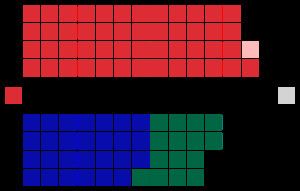3 March 1956 (1956-03-03) 1959 → 57 seats 36 seats 7 6 Start date March 3, 1956 | 2 April 1952 20 September 1955 50 seats 42 seats 47.25% 46.25% | |
 | ||
Winner Joseph Cahill | ||
The 1956 New South Wales state election was held on 3 March 1956. It was conducted in single member constituencies with compulsory preferential voting and was held on boundaries created at a 1952 redistribution. The election was for all of the 94 seats in the Legislative Assembly.
Contents
Issues
In March 1956, Labor had been in power for 15 years and Joseph Cahill who had won a landslide victory at the 1953 election had been premier for 4 years. Cahill, who was commonly known as "old smoothie" had been a popular premier and had shown some flair in leadership by announcing a design competition for the Sydney Opera House in September 1955. However, nationally the Labor party was divided on sectarian and ideological grounds. In Victoria, many members of the predominantly Catholic right-wing of the party had left the party and joined the nascent Democratic Labor Party (DLP). Cahill was desperate to keep the New South Wales branch of the ALP united. He achieved this by controlling the anti-DLP faction led by his ex-minister Clive Evatt (brother of H V Evatt) while at the same time keeping the right-wing faction within the party. Cahill's attempts at unity were assisted by the state's Catholic hierarchy who were less politically involved than their Victorian counterparts under Daniel Mannix. As a result, the effects of this split were not as severe in New South Wales and the DLP did not contest the 1956 state election. However, the split did have a significant effect on the Labor Party's vote and contributed to the loss of the seat of Waratah.
Labor's election promises included making the supply of state housing a top priority, reviving the State Bank which had been under the control of the federal government since 1932 and revitalizing the state's railways including the long delayed Eastern Suburbs line.
The coalition of the Liberal Party and Country Party coalition continued to suffer from leadership issues. Murray Robson had replaced Vernon Treatt as the Liberal Party leader and Leader of the Opposition in August 1954, but had proved inept for the position and was replaced by Pat Morton as leader in September 1955. Morton was a somewhat aloof figure, with a public presence more typical of pre-war conservative politicians, and found it difficult to connect with the public. Michael Bruxner continued as the leader of the Country Party.
The opposition campaigned on the government's broken promises and uncompleted public works as well as resentment against compulsory unionism and the implementation of the Cumberland Plan, which reserved a large area of the Sydney Basin from development. The coalition promised that the state transport system would be run along the lines of private enterprise and cease to be a drain on the state's budget. Bruxner called Cahill's plans a death bed repentance with no incentives for rural development.
Results
The result of the election was a clear victory for Labor despite a net loss of 7 seats:
The results gave Labor a parliamentary buffer of 3 seats plus the usual support of Tom Armstrong.
Labor losses were largely confined to the marginal or usually conservative seats that it had unexpectedly won at the 1953 election including Armidale, Coogee, Drummoyne, Georges River, Parramatta, and Sutherland. Labor regained the seat of Hartley from Independent Labor member Jim Chalmers who unsuccessfully contested Nepean as an independent. The loss of the usually safe seat of Waratah was a shock for Labor and was caused by a number of factors. The popular Labor incumbent Robert Cameron had retired and after a bitter pre-selection battle, Labor endorsed a Tighes Hill butcher, Harry Sheedy. Sheedy was a member of the socialist wing of the party and, at a time when the party was split on sectarian and ideological grounds, was disliked by many among the large and usually Labor voting Catholic population in the electorate. His main opponent and the winner of the seat was the independent, Frank Purdue who was prominent in local Government and the popular Lord Mayor of Newcastle.
Seats changing party representation
‡ The seat of Kahibah was won by Independent Labor candidate Tom Armstrong at the 1953 by-election caused by the resignation of Labor's Joshua Arthur
Tabulated results
1 There were 1,846,859 enrolled voters in 86 contested electorates and 164,399 were enrolled in 8 uncontested electorates (2 Labor, 3 Liberal and 3 Country ).Aftermath
Joe Cahill's triumph at this election ensured that he remained premier during the course of the parliament. Pat Morton remained Leader of the Opposition but Michael Bruxner finally retired as Leader of the New South Wales National Party, a position he had held since 1932 and was replaced by Davis Hughes in 1958. During the parliament there were 6 by-elections. This led to changes in party representation in Kahibah where the endorsed Labor candidate Jack Stewart won the by-election caused by the death of the Independent Labor incumbent Tom Armstrong and in Wagga Wagga the Liberal's Wal Fife won the by-election caused by the death of the Labor incumbent Eddie Graham. These results effectively reduced the government's majority by 1.
